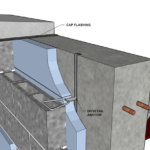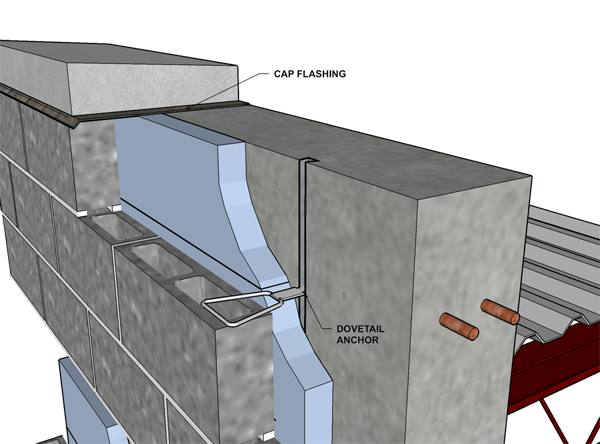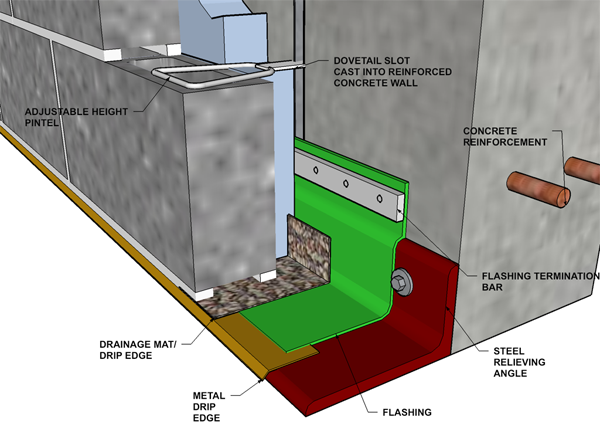Concrete Block Veneer / Reinforced Cast in Place Concrete
The excellent insulating value and heat capacity of masonry and concrete make this system a good choice for schools and commercial buildings.

Recommended Building Types
- Interior partitions, fire separation walls
- Schools, commercial and institutional buildings
- Buildings requiring high fire rating
- Noisy environments
- Areas with frequent rainfall
- Choosing the Right Masonry System for your Budget
Benefits
- Durable, long-lasting wall system
- Minimal long-term maintenance
- Great design flexibility – use different colors, bond patterns, and surface textures to spice up your design
- Poured concrete backup acts as the structure, with vertical and horizontal reinforcement built into the wall
- Cavity system inherently weatherproof – great for moist environments
- Excellent insulating value and heat capacity
- Inherently fire proof with fire rating of 4 hours
- Great for noisy environments – naturally dampens sound
Special Considerations
- Lower life cycle costs offset high initial investment
- This substantial wall system may require larger foundations
- Two trades required for construction – masonry contractor for the façade, and a concrete contractor for the backup – which can complicate jobsite coordination
- Construction times are longer than for an equivalent masonry (brick/block) wall
- Cast-in-place concrete is not a desirable interior finish. Will need to provide final finished surfaces after wall is built
Definition and Assumptions
Backup: Reinforced 8″ thick concrete wall. #5 reinforcement at 12 inches o.c. each direction, 2 mats of steel
9-gauge triangular ties in dovetail slots embedded in concrete. Install the dovetail slots vertically @ 24″ o.c. Install ties in the slots @ 16″ o.c.
Veneer: Cored modular brick 4″ x 2-13″ x 8″ (nom.).
Insulation: 2 inch extruded polystyrene rigid insulation in 3 inch drainage cavity.
Flashing: Base Flashing and weeps.
Mortar: Type N, Portland cement/lime, plain gray.
Joints: Concave tooled.
Regional Variations
- When masonry veneer is used in areas of high seismic risk, Veneer ties are required to attach to wire reinforcement embedded in Mortar bed joints in the veneer. Check your local requirements – and save money by using normal Veneer ties in areas of low seismic risk.
- Many areas of the western U.S. have good local sources for lightweight aggregate, and the use of lightweight concrete block (CMU) is the norm. In other parts of the country, medium weight and normal weight block are more common.
Fire Rating (hours)
Sound Transmission Class (dB)
STC 62.7
STC=(weight of wall)0.223x21.5
Wall Weight (lb/sq. ft.)
122 lb/sq. ft.
Energy Rating
R-value: 11.9 with 2” extruded polystyrene rigid insulation (See note)
Calculation:
| Outside Air | =0.17 |
| 4 inch block | =1.19 |
| Air Gap | =0.97 |
| Insulation | =8.00 |
| Gyp board | =0.45 |
| 8 inch concrete | =0.88 |
| Interior Air | =0.68 |
| Total | =11.89 |
- R-Value/U-Factor Calculator (configurable)
- R-Values of Multi-Wythe Concrete Masonry Walls
- Introduction to Energy Performance of Brick Masonry
Note: The type of rigid insulation you install affects the wall’s insulating capacity (the R-value). Polyisocyanurate insulation gives you 8.0 R per inch (or 12.0 R for 1.5″). Extruded polystyrene insulation is worth 4.0 R per inch (6.0 R for 1.5″). Expanded polystyrene yields 5.0 R per inch (7.5 R for 1.5″). Use either thicker insulation or more expensive polyisocyanurate to achieve a higher rating.
Sustainability & LEED
- Energy efficiency, thermal comfort and energy analysis – up to 10 pts
- Innovation and design – 1 pt
- Recycled content – 2 pts
- Regional material (where applicable) 2 pts
- Renewable energy and thermal mass – up to 10 pts
- Concrete Masonry and the LEED Program
- Determining the Recycled Content of Concrete Masonry Products
Design Tips
- Place rigid-board insulation in the drainage cavity to maximize interior usable space, and take advantage of the huge thermal mass provided by the concrete backup system.
- Concrete block (CMU) veneer shrinks as it ages. Don’t forget to detail expansion joints in the CMU veneer and concrete backup.
- Install horizontal reinforcing in the concrete block veneer @ 16 inches o.c. to control cracking.
- Shelf angles may not be required for veneer support at every floor line. Cut down on the number of shelf angles to save money and simplify your construction. If your veneer is shorter than 30 feet above the top of the foundation wall, you may not need relieving angles at all.
Construction Tips
- Back bevel Mortar joints to prevent excess Mortar from falling into the drainage cavity.
- Dovetail slots are expensive for the concrete contractor to install and are often left out. You may need to face-mount dovetail slots using anchors installed into the concrete.




